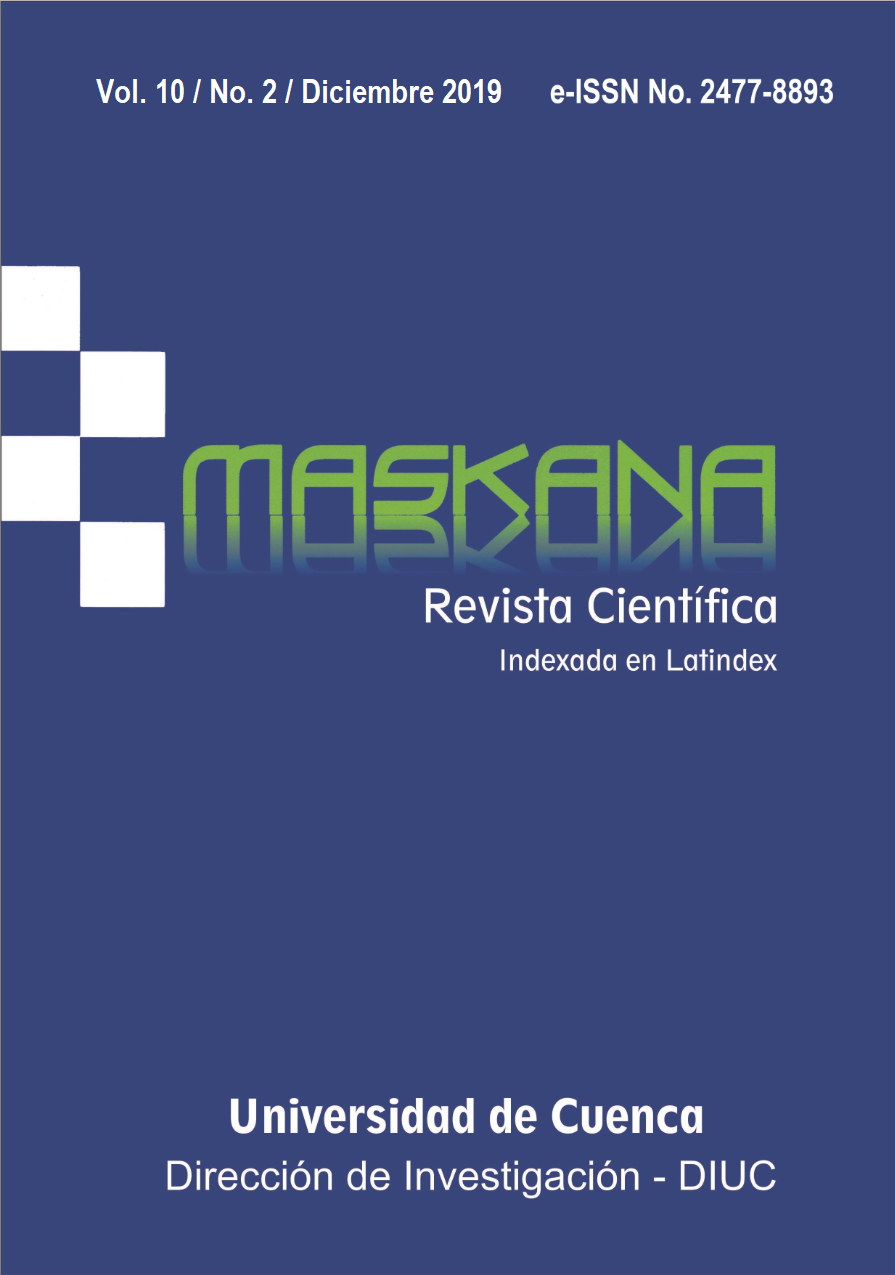Experiences in the Application of the Flipped Learning Model in a Music Technology Course
DOI:
https://doi.org/10.18537/mskn.10.02.02Keywords:
ICTs, flipped learning, music technology, Ableton LiveAbstract
The increasing use of information and communication technologies (ICTs) modified many tasks and strongly altered our behaviors. Having this in mind, the Flipped Learning (FL) model provides a promising learning alternative that links the learning environment with the student’s behavior while altering the traditional instruction model. The FL model involves activities in which students individually review online materials and develop projects and assignments in groups and on-site. The objective of this study was to evaluate the flipped learning model in arts education, more precisely how the introduction of this model affects the learning of the students from the University of Cuenca attending the course of music technology. The findings of this study highlighted the benefits of active learning and the acceptance of the material developed for the implementation of the FL model. Notwithstanding, the overall positive evaluation of the FL approach, the authors suggest carrying out more studies, involving a larger student population, to better identify and remedy remaining obstacles, what will facilitate the use of the FL model in other courses.
Downloads
Metrics
References
Bush, M. D. (2013). Educational technology points of inflection: what MOOCs, flipped classrooms, and OLPC teach us about individualization of learning. Educational Technology, 53(6), 60-63.
Fidalgo-Blanco, A., Martinez-Nuñez, M., Borrás-Gene, O., & Sanchez-Medina, J. J. (2017). Micro flip teaching - An innovative model to promote the active involvement of students. Computers in Human Behavior, 72, 713-723. https://doi.org/10.1016/j.chb.2016.07.060
Flipped Learning Network. Definition of Flipped Learning. (n.d.). Retrieved from https://flippedlearning.org/definition-of-flipped-learning/
Garrison, D., & Kanuka, H. (2004). Blended learning: Uncovering its transformative potential in higher education. The Internet and Higher Education, 7(2), 95-105. https://doi.org/10.1016/j.iheduc.2004.02.001
Goodwin, B., & Miller, K. (2013). Evidence on flipped classrooms is still coming in. Educational Leadership, 70(6), 78-80.
Humante-Ramos, P., García-Peñalvo, F., & Conde-González, M. Á. (2016). Encuesta sobre el uso de Internet, servicios sociales y herramientas tecnológicas de los estudiantes de la carrera de ingeniería en sistemas y computación en la Facultad de Ingeniería de la UNACH [Survey on the use of Internet, social media, and technological tools of students in the computer engineering degree at the School of Engineering of the National University of Chimborazo -UNACH] [Data set]. Figshare. https://doi.org/10.6084/m9.figshare.3413869
Heeseung, C., Jeongeun, K., Kyung-Sook, B., Yeon-Hwan, P., Nam-Ju, L., & Chanhee, K. (2015). Applying the Flipped Learning Model to an English-Medium Nursing course. Journal of Korean Academy of Nursing, 45(6), 939-48. https://doi.org/10.4040/jkan.2015.45.6.939
Hussey, H. D., Richmond, A. S., & Fleck, B. (2015). A primer for creating a flipped psychology course. Psychology Learning & Teaching, 14(2), 169-185. doi:10.1177/1475725715592830
Hootsuite Media Inc. (n.d.). Digital in 2018 in Southern America. Retrieved from: https://hootsuite.com/es/pages/digital-in-2018
Kim, H. S., Kim, M. Y., Cho, M., & Jang, S. J. (2017). Effectiveness of applying flipped learning to clinical nursing practicums for nursing students in Korea: A randomized controlled trial. International Journal of Nursing Practice, 23(5), 1-10. https://doi.org/10.1111/ijn.12574
Kim, J. A., Heo, H. J., & Lee, H. (2015). Effectiveness of flipped learning in Project Management Class. International Journal of Software Engineering and Its Applications, 9(2), 41-46.
Lee, J., Lim, C., & Kim, H. (2016). Development of an instructional design model for flipped learning in higher education. Educational Technology Research and Development, 65(2), 427-453. https://doi.org/10.1007/s11423-016-9502-1
Marín-Juarros, V. (2014). Modelos de rediseño de acciones formativas en el entorno virtual de enseñanza-aprendizaje [Redesign models for training activities in online teaching and learning]. Tesis doctoral, Departament de Pedagogia Aplicada i psicología de l’Educació, Universitat de les Illes Balears, 549 pp. https://www.researchgate.net/publication/273452427_Modelos_de_rediseno_de_acciones_formativas_en_el_entorno_virtual_de_ensenanza-aprendizaje_Diseno_y_experimentacion_de_estrategias_metodologicas_de_integracion_de_los_entornos_institucionales_y_abierto
Mason, G. S., Shuman, T. R., & Cook, K. E. (2013). Comparing the Effectiveness of an Inverted Classroom to a Traditional Classroom in an Upper-Division Engineering Course. IEEE Transactions on Education, 56(4), 430-435. https://doi.org/10.1109/TE.2013.2249066
Mennella, T. A. (2016). Comparing the efficacy of flipped vs. alternative active learning in a College Genetics Course. The American Biology Teacher, 78(6), 471-479. https://doi.org/10.1525/abt.2016.78.6.471
Murphy, J., Chang, J.-M., & Suaray, K. (2016). Student performance and attitudes in a collaborative and flipped linear algebra course. International Journal of Mathematical Education in Science and Technology, 47(5), 653-673. https://doi.org/10.1080/0020739X.2015.1102979
Noor-Akmal, S., I. (2016). Effectiveness of team-based learning in teaching medical genetics to medical undergraduates. Malaysian Journal of Medical Sciences 23(2), 73-77.
O’Connor, E. E., Fried, J., McNulty, N., Shah, P., Hogg, J. P., …, et al. (2016). Flipping radiology education right side up. Academic Radiology, 23(7), 810-22. http://dx.doi.org/10.1016/j.acra.2016.02.011
Oh, J., Kim, S., Kim, S., & Vasuki, R. (2017). Evaluation of the effects of flipped learning of a nursing informatics course. The Journal of Nursing Education, 56(8), 477-83. https://doi.org/10.3928/01484834-20170712-06
Pence, P. L. (2016). Flipping a first-year medical-surgical associate degree registered nursing course: A 2-year pilot study. Teaching and Learning in Nursing, 11(2), 52-57. https://doi.org/10.1016/j.teln.2015.12.006
Sams, A., & Bergmann, J. (2013). Flip your students' learning. Educational Leadership, 70(6), 16-20.
Smith, C. M., & McDonald, K. (2013). The flipped classroom for professional development: Part II. Making podcasts and videos. The Journal of Continuing Education in Nursing, 44(11), 486-487. https://doi.org/10.3928/00220124-20131025-93
Published
How to Cite
Issue
Section
License
Copyright © Autors. Creative Commons Attribution 4.0 License. for any article submitted from 6 June 2017 onwards. For manuscripts submitted before, the CC BY 3.0 License was used.
![]()
You are free to:
 |
Share — copy and redistribute the material in any medium or format |
 |
Adapt — remix, transform, and build upon the material for any purpose, even commercially. |
Under the following conditions:
 |
Attribution — You must give appropriate credit, provide a link to the licence, and indicate if changes were made. You may do so in any reasonable manner, but not in any way that suggests the licenser endorses you or your use. |
| No additional restrictions — You may not apply legal terms or technological measures that legally restrict others from doing anything the licence permits. |









